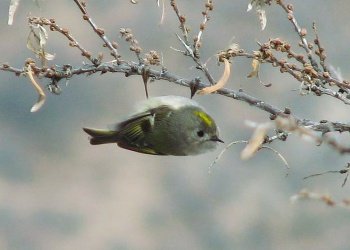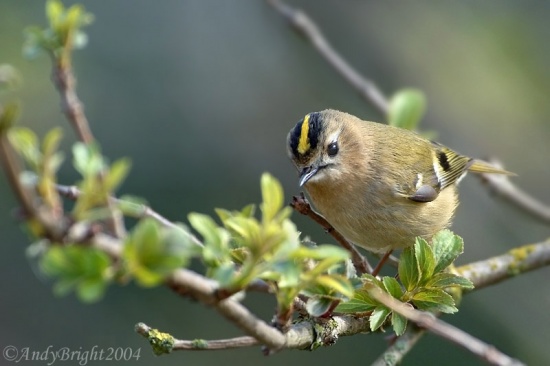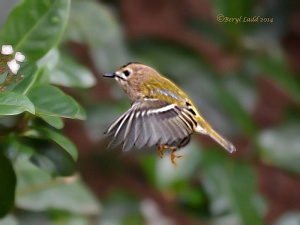Includes: Canary Islands Goldcrest
- Regulus regulus
Identification

Photo © by Askar Isabekov
Ile-Alatau National Park, Kazakhstan, January 2007
Length 9 cm (3½ in), weight 5-7 g
Adult
- Olive-green upperparts
- Wings have two white wing bars and a dark mark
- Dull whitish-buff underparts
- Head: black border to orange (male) or yellow-orange crown (female), or plain olive-green (juvenile)
- Thin black bill
- Narrow black moustachial line
- Brown legs
Variations
The subspecies differ in colour tone (R. r. coatsi the palest, R. r. yunnanensis the darkest), and the width and intensity of the black crown border. In most, the black border does not extend across the forehead, but it does in R. r. teneriffae (as also in Common Firecrest). In R. r. tristis, the body plumage is greyer, and the crown border is grey-brown, not black (see right).
Similar Species
Common Firecrest has a white supercilium and black eyestripe.
The tiny size and lack of supercillium distinguishes it from all other small green warblers.
Distribution
Widespread throughout Europe and temperate Asia; scarce winter visitor to northwest Africa. Sedentary or short-distance migrant; vacates colder northern areas in winter. Occurs from sea level, to a maximum of 4,000 m altitude in the Himalaya.
Taxonomy
Subspecies
There are 12 to 14 subspecies[1][2][3]:

Photo © by katastrofa
Garajonay National Park, La Gomera, Canary Islands, February 2019
- R. r. regulus (includes R. r. anglorum, R. r. interni): Europe to Asia Minor and western Siberia; winters to Mediterranean
- R. r. azoricus : Azores (São Miguel Island)
- R. r. sanctaemariae: Azores (Santa Maria Island)
- R. r. inermis: western Azores (Flores, Faial, Pico, São Jorge and Terciera)
- R. r. teneriffae: Canary Islands (sometimes split as full species Canary Islands Goldcrest)
- R. r. ellenthalerae: western Canary Islands (included in R. r. teneriffae by some authors[1])
- R. r. buturlini: Crimea, Caucasus and Azerbaijan; winters to northern Iran
- R. r. hyrcanus: eastern Turkey (Alborz mountains) to northern Iran (southern Caspian District)
- R. r. coatsi: western Siberia to Altai Mountains; winters to southern Nan Shan Mountains
- R. r. tristis: mountains of central Asia; winters to Transcaspia and western Iran
- R. r. himalayensis: Himalaya of Afghanistan to Pakistan and Nepal
- R. r. sikkimensis: Himalaya of Nepal to south-eastern Tibet and western China
- R. r. japonensis: mountains of Manchuria to northern and eastern China, Korea and Japan
- R. r. yunnanensis: mountains of western China (southern Gansu and Shaanxi to Sichuan and Yunnan)
Habitat
Forests, woods and large gardens with scattered trees. Prefers conifers for breeding. Can be found in gorse and other scrub on heaths outside of the breeding season.
Behaviour
Often joins mixed tit flocks in the winter. In very tall conifers (40-60 m tall), will form vertically stacked breeding territories with separate pairs in upper and lower canopy.
Flight
Undulating flight. Often hovers when feeding in the tree canopy.
Diet
The diet consists mainly of small insects and spiders.
Breeding
The nest is suspended under a conifer branch.
Vocalisation
Recorded by Andrew Whitehouse
Inchgarth, Aberdeen, Scotland, March 2010
References
- Clements, J. F., T. S. Schulenberg, M. J. Iliff, D. Roberson, T. A. Fredericks, B. L. Sullivan, and C. L. Wood. 2018. The eBird/Clements checklist of birds of the world: v2018. Downloaded from http://www.birds.cornell.edu/clementschecklist/download/
- Gill, F and D Donsker (Eds). 2014. IOC World Bird Names (version 4.3). Available at http://www.worldbirdnames.org/.
- Del Hoyo, J, A Elliot, and D Christie, eds. 2006. Handbook of the Birds of the World. Volume 11: Old World Flycatchers to Old World Warblers. Barcelona: Lynx Edicions. ISBN 978-8496553064
- Collins Pocket Guide to British Birds 1966
- Collins Field Guide 5th Edition
- Collins Bird Guide ISBN 0 00 219728 6
Recommended Citation
- BirdForum Opus contributors. (2025) Goldcrest. In: BirdForum, the forum for wild birds and birding. Retrieved 13 May 2025 from https://www.birdforum.net/opus/Goldcrest
External Links
Search specifically for Tenerife Goldcrest:
GSearch checked for 2020 platform.






